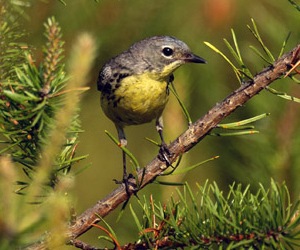A recent annual survey of the federally endangered Kirtland’s warbler shows its population still remains near an all-time high.
Biologists, researchers and volunteers observed 2,004 singing males during the official 2013 survey period – 2,063 males were observed in 2012. In 1974 and 1987, when the lowest survey numbers were recorded, only 167 singing males were found.
“Although we do have a slight decrease of singing males this year,” said Dan Kennedy, DNR endangered species coordinator, “we are really excited to see these high numbers because many conservation groups have worked together for over 40 years to make this possible.”
The Kirtland’s warbler survey is conducted each year in a joint effort between the DNR, U.S. Forest Service, U.S. Fish and Wildlife Service, Michigan Department of Military and Veterans Affairs, Michigan Audubon Society and numerous citizen volunteers.
During early June, when birds are actively singing and defending their nesting area, warblers are noted by listening for their song. The song can be heard up to one-quarter of a mile away. Only the males sing, so estimates of breeding population are obtained by doubling the number of singing males recorded.
Kirtland’s warblers nest on the ground and typically select nesting sites in stands of jack pine between 4 and 20 years old. Historically, these stands of young jack pine were created by natural wildfires that frequently swept through northern Michigan. Modern fire suppression programs altered this natural process, reducing Kirtland’s warbler habitat. The result was that the population of Kirtland’s warblers declined to the point that they were listed as endangered.
To mimic the effects of wildfire and ensure the future of this species, the DNR, U.S. Forest Service, and U.S. Fish and Wildlife Service manage the forests through a combination of clear-cutting, burning, seeding and replanting to promote habitat for the Kirtland’s warbler and many other species, including snowshoe hare, white-tailed deer, other songbird species and rare plants. Because large prescribed fires are neither safe nor economical in northern Michigan, approximately 3,000 acres of jack pine trees are harvested and replanted annually on state and federal lands.
For more information about this rare bird, visit the DNR’s Kirtland’s warbler Web page.

